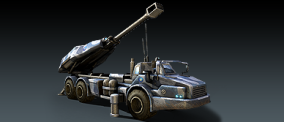Claymore (Artillery): Difference between revisions
m (1 revision imported) |
Revision as of 02:33, 15 March 2019
| Claymore | |
|---|---|
 Claymore concept | |
| Type | Self-propelled artillery |
| Place of origin | |
| Service history | |
| In service | 1998 - present |
| Production history | |
| Designer | Goldeneagle Defensive Works |
| Designed | 1994 |
| Manufacturer | Goldeneagle Defensive Works |
| Produced | 1998 - present |
| Specifications (Claymore) | |
| Weight | 16 tons |
| Length | 11.1 m |
| Width | 2.6 m |
| Height | 3.9 m |
| Crew | 3 |
| Armor | welded steel, 14.5 mm resistant additional bomblet protection |
Main armament | 155mm self-loading howitzer |
Secondary armament | 7.62 mm machine gun |
| Engine | Griffincrest multi-fuel turbine 480 horsepower |
| Suspension | Wheeled |
| Speed | 67 km/h on road, 45 km/h off road |
The Claymore is a Scottopian 155 mm self-propelled howitzer developed by Goldeneagle Defensive Works of the Blackhelm Confederacy for the Royal Scottopian Army. The Claymore is one of the most powerful conventional artillery systems deployed in Astyria. It is particularly notable for a very high rate of fire; in burst mode it can fire three rounds in 9 seconds, ten rounds in 56 seconds, and can—depending on barrel heating—fire between 10 and 13 rounds per minute continuously. The Claymore has automatic support for up to 5 rounds of Multiple Rounds Simultaneous Impact (MRSI). The replenishment of shells is automated. Two operators can load 60 shells and propelling charges in less than 12 minutes.
Development
In 1994, the Royal Scottopian Army came to Goldeneagle Defensive Works with a design for a brand new, state of the art 155mm self-proppelled artillery piece. Goldeneagle responded by designing the 155 mm 52-calibre compliant gun, which is chromium-lined for its entire 8 metre length and includes a muzzle brake on the end. The gun uses a new modular charge system with six charges (five identical), which can be combined to provide the optimal total charge for the range to the target, as well as the conventional bagged charge systems. Primer is loaded separately via a conveyor belt, and the entire loading, laying and clearing is completely automated. The maximum range of the gun is 30 km with the standard round, about 35 km with base bleed rounds, and at least 40 km with assisted projectiles.
The turret includes a phased array radar on the front glacis for measuring the muzzle velocity of each round fired. Laying data can be automatically provided via encrypted radio from the battery fire direction centre. A lighter, more air-portable version, using the gun in a module fitted to a lighter chassis, has been developed as well.